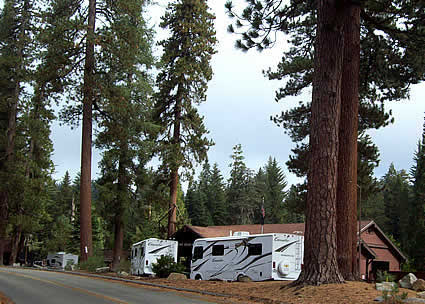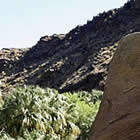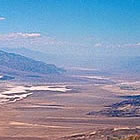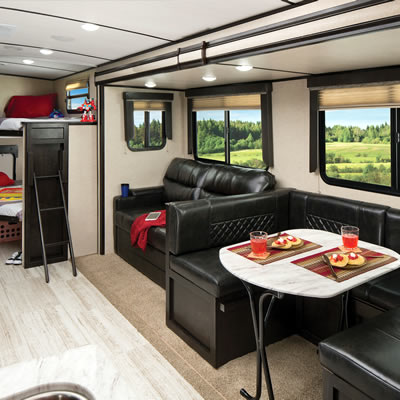A tour of King’s Canyon National Park
See unbelievable sights at this stunning location

As the temperature starts to drop in Canada, many of you will be preparing to head south for the winter. Your final destination may be Southern California, Arizona or even as far away as the Rio Grande Valley in Texas. Our recent article on the Northern Hemisphere Initiative will help you enter the USA trouble-free and also provide you with some ideas as to where to go. Lynne Benjamin’s recent article on checklists will help you as you prepare to leave and while en route. But before you pull out, think about interrupting your trip with a short stop along the way. Consider a worthwhile diversion to the western side of the Sierra Nevada Mountains, where Kings Canyon National Park and the Sequoia National Forest are located. These two US Government facilities occupy 48,668 acres and are breathtakingly beautiful.
Here is what we saw and did when we decided to veer off of I-5 or CA 99. For starters, we rose in elevation, starting at less than 305 metres (1,000 feet), and reaching almost 2,134 metres (7,000 feet) above sea level. We were travelling on CA 180, a good road but one with plenty of overlooks (lay-bys) before you reach the top. Our first stop was at the Hume Lake Ranger Station, where we collected a map, obtained road conditions and learned of any vehicle restrictions. (More about the latter later).
Natural history at its finest
The visitor centre is small but the staff is friendly. Outside, we inspected a reconstructed Dolbeer Donkey, a device that was used to skid logs out of the forest. The elevation at this point was 823metres (2,700 feet) and we were in the Sequoia National Forest. The forest was designated in 1908 and, if the trees had voices, they would relate tales of Native Americans, cattle and sheep drives, gold prospectors, lumber camps, early resorts, pack stations and isolated fire towers. Presently, the land is used more for recreation than for work. Fishing, camping, rafting and kayaking are popular, as are boating and jet skiing on Lake Isabella reservoir. Overlooking all of these human activities are the giant Sequoia trees. You will find the most expansive grove of these giants in the world here.
We had entered the Kings Canyon Scenic Byway and were about to enter Kings Canyon National Park and the Giant Sequoia National Monument. The Byway is the only vehicular route into Kings Canyon and runs for 80 kilometres (50 miles) through many varied areas of the Sierra Nevada Mountains. Hume Lake (87 acres) is 32 kilometres from the entrance and was formed by a multi-arch dam in 1908. It was originally built for commercial logging but today it is the favourite year round recreation area. Baskin Grove offers a rare opportunity to photograph an entire Sequoia in one frame. The Boole Tree stands 81 metres (268 feet) high.
In the early 1900s, Brewer and Gardner described this area as follows: “Kings Canyon is a valley of one-half to one mile wide at the bottom, eleven miles long and closed at the bottom by deep inaccessible ravines, surrounded by grand precipices, with altitudes that rival or even surpass Yosemite.” Two hundred years later, this description is still accurate. Unlike most National Parks, the visitor centre is not at the entrance but is actually located three miles inside the park. We climbed to an elevation of 1,219 metres (4,000 feet) and at the spacious visitor centre we viewed a video, observed the many exhibits of life this high up and browsed through the gift shop. Oh, don’t forget to pay the entrance fee of $20US per vehicle.
Onward to the grove
From here, we travelled a short distance to the General Grant Grove. The attraction here is a behemoth of a tree, the General Grant Tree, which is over 2,000 years old and still growing, even at an elevation of 2,008 metres (6,589 feet). Nearby is the General Sherman Tree, another giant. Camera at the ready, we took dozens of photos. These Giant Sequoias, the most massive trees on earth, can grow to 10 metres (36 feet) in diameter, reach 88 metres (290 feet) tall, weigh over 1,300 tons and live to be between 900 to 2,000 years. Back in the truck, we continued along the Byway to Boyden Cave. Surprisingly, we had dropped to an elevation of 934 metres (3,063 feet). The cave is available for touring during the summer months, for a small fee. From here, CA 180 is fairly straight (as mountain roads go) and now runs along the river. Our last stop was the Sentinel Campground, one of four in the area.
The Cedar Grove Visitor Center and Village required a detour and Roads End was only a few miles away. We chose to explore the campground and found it to be quite beautiful. There are many trees, but only limited amenities. Beyond Roads End, you are in the John Muir Wilderness Area and the Sierra National Forest. Unfortunately, there are no through roads to US 395 via the other side of the mountains. So around we turned and retraced our route, giving the passenger a better view of the river and the canyon. At over 2,438 metres (8,000 feet) deep, Kings Canyon is actually deeper than the Grand Canyon in Arizona. And of course, the Sierra Nevada Mountains surround the Scenic Byway, with many peaks visible. Approaching the visitor centre, we again caught glimpses of the giant Sequoia trees. Leaving the park, one is reminded of the old adage, “what goes up must eventually come down," and so we continued our long descent back to CA 99, dropping from 2,100 metres to just over 150 metres. Ears popping, we were exhilarated by the time we had spent high up in the mountains.
One last point, although parts of the Byway are curvy and rise in elevation over its 80-kilometre span, we passed many fifth wheels heading into the park as we were leaving. The campgrounds are spacious but obviously do not have full hookups. There are two RV parks near the Hume Lake Ranger Station, so spending the night there and touring the park in a tow vehicle is an easier way to go. Nevertheless, there are those road restrictions we mentioned earlier:
- There is a loop, the Generals Highway, which links CA 180 and CA 198. Vehicles over 22 feet in length are not advised between Potwisha and Giant Forest Museum in the Sequoia National Forest
- Gasoline is not available in the National Park but can be purchased in the National Forest.
- Snow is always a possibility when you are travelling in the mountains. The Kings Canyon Visitor Center is opened all year round but many of the side roads may be closed when it snows. There is a market, lodge, and post office at the centre.
- For general information, call 1-559-565-3341 or visit www.nps.gov/seki
- For food and lodging in Kings Canyon NP, call 1-559 335-5500
- For the Wuksachi Village and Lodge in Sequoia NF, call 1-888 252-5757
- For camping, call 1-877-444-6777 or visit www.recreation.gov.








